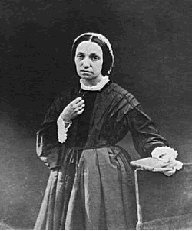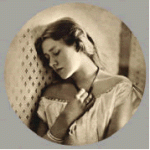Moving now to the art of photography and the life of an inspirational British photographer (and shrewd businesswoman) who was given her first camera at the age of 48 as a present. Cameron’s work was strongly influenced by the Pre-Raphaelite painters – Millais, Rossetti, Holman Hunt and Watts is recognised today as being decades ahead of her time.
Julia Margaret Cameron June 11, 1815 – January 26, 1879
Julia Margaret Cameron was a British photographer. Cameron is widely known for her portraits of celebrities of the time and for Arthurian and similar pictures of myths and legends.

Cameron’s photographic career was short (about 12 years) and came late in her life. Her work had a huge impact on the development of modern photography, especially her closely cropped portraits which are still mimicked today.
Born in Calcutta in 1815, educated in Europe and returned to her parents home at the Cape of Good Hope in 1836. In 1838 she met and married Charles Hay Cameron. On her husband’s retirement, in 1848, the couple moved to London and Julia became part of Kensington’s artistic community, including poet Henry Taylor, painter G F Watts, and Poet Laureate Alfred, Lord Tennyson.
In 1860 she bought two cottages in Freshwater Bay in the Isle of Wight – they were linked together with a Gothic tower and renamed Dimbola Lodge after the family tea estates in Ceylon. Julia lived at Dimbola Lodge from 1860 until 1875, and the Julia Margaret Cameron Trust was set up with the aim of ensuring the preservation of Dimbola Lodge, and to provide historical information on Julia Margaret Cameron’s life and works. Dimbola Lodge Museum is situated in Terrace Lane, close to Freshwater Bay on the Western end of the Isle of Wight.
In 1863, when Cameron was 48 years old, her daughter gave her a camera as a present, thereby starting her career as a photographer. Within a year, Cameron became a member of the Photographic Societies of London and Scotland. In her photography, Cameron strove to capture beauty. She wrote:
“I longed to arrest all the beauty that came before me and at length the longing has been satisfied.”
Cameron was sometimes obsessive about her new occupation, subjects sitting for countless exposures in the blinding light as she laboriously coated, exposed, and processed each wet plate. The results were, in fact, unconventional in their intimacy and their particular visual habit of creating blur through both long exposures where the subject moved and by leaving the lens intentionally out of focus. This led some of her contemporaries to complain and even ridicule the work, but her friends and family were supportive and she was one of the most prolific and advanced amateurs of her time. Her enthusiasm for her craft meant that her children and others sometimes tired of her endless photographing, but it also means that we are left with some of the best of records of her children and of the many notable figures of the time who visited her.
During her career, Cameron registered each of her photographs with the copyright office and kept detailed records. Her shrewd business sense is one reason that so many of her works survive today. Another reason that many of Cameron’s portraits are significant is because they are often the only existing photograph of historical figures. Many paintings and drawings exist, but, at the time, photography was still a new, challenging medium for someone outside a typical portrait studio.

The bulk of Cameron’s photographs fit into two categories: closely framed portraits (like this early photograph of the English stage actress, Dame Ellen Terry, GBE) and illustrative allegories based on religious and literary works. In the allegorical works in particular, her artistic influence was clearly Pre-Raphaelite, with far-away looks, limp poses and soft lighting.
Cameron’s sister ran the artistic scene at Little Holland House, which gave her many famous subjects for her portraits. Some of her famous subjects include: Charles Darwin, Alfred Lord Tennyson, Robert Browning, John Everett Millais, William Michael Rossetti, Edward Burne-Jones, Ellen Terry (above) and George Frederic Watts. Most of these distinctive portraits are cropped closely around the subject’s face and are in soft focus. Cameron was often friends with these Victorian celebrities, and tried to capture their personalities in her photos. Her neighbour on the Isle of Wight, Alfred Lord Tennyson often brought friends to see the photographer.
Cameron’s posed photographic illustrations represent the other half of her work. In these illustrations, she frequently photographed historical scenes or literary works, which often took the quality of oil paintings. However, she made no attempt in hiding the backgrounds. Cameron’s friendship with Tennyson led to his asking her to photograph illustrations for his Idylls of the King. These photographs are designed to look like oil paintings from the same time period, including rich details like historical costumes and intricate draperies. Today, these posed works are sometimes dismissed by art critics. Nevertheless, Cameron saw these photographs as art, just like the oil paintings they imitated.
In 1875 the Camerons moved back to Sri Lanka (during the nineteenth century this country was known as Ceylon). Julia continued to practice photography but complained in letters about the difficulties of getting chemicals and pure water to develop and print photographs. Also, in India, she did not have access to Little Holland House’s artistic community. She also did not have a market to distribute her photographs as she had in England. Because of this, Cameron took fewer pictures in India. These pictures were of posed Indian natives, paralleling the posed pictures that Cameron had taken of neighbours in England. Almost none of Cameron’s work from India survives. Cameron died in Ceylon in 1879.
Cameron’s niece Julia Prinsep Stephen née Jackson wrote the biography of Cameron which appeared in the first edition of the Dictionary of National Biography, 1886. Julia Stephen was the mother of Virginia Woolf, who wrote a comic portrayal of the “Freshwater circle” in her only play Freshwater. Woolf edited, with Roger Fry, a collection of Cameron’s photographs, Victorian Photographs of Famous Men and Fair Women, published in 1926. However, it was not until 1948 that her photography became more widely known when Helmut Gernsheim wrote a book on her work (Julia Margaret Cameron: Her Life and Photographic Work, London: The Fountain Press, 1948).
****************************************************************
From translating inspiration and ideas into words and images perhaps we now need to consider the communication and sharing of ideas via technological innovation. In the “Noughties” we have so many ways to communicate with each other. But we mustn’t forget that the 24/7 space that never sleeps “ http://www.” “Web” wasn’t created until 1989 (by the Englishman Sir Tim Berners-Lee and the Belgian Robert Cailliau) and it wasn’t until the early 1990s, that mobile phones became small enough to carry in your pocket,
Women have played a major historical part in providing the technological platforms that are ubiquitous in the 21st century. Their stories will be the subject of the next series of posts. Women in computing
Legal bit
All rights reserved. No part of this publication may be reproduced, in any form or by any means, electronic, mechanical, photocopying, recording or otherwise, without the prior permission of the authors. Although great care has been taken to ensure the accuracy and completeness of the information contained in this work neither the author, contributors, employees or advisers are able to accept any legal liability for any consequential loss or damage, however caused, arising as a result of any actions taken on the basis of the information contained in this work. All third party brands and trademarks belong to their respective owners. Copyright : Maggie Baldry